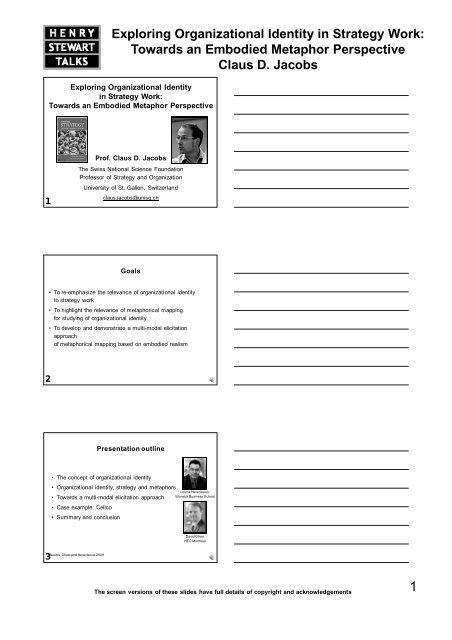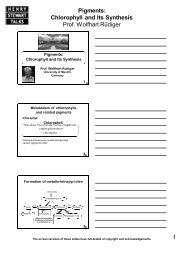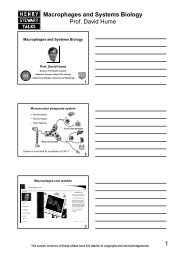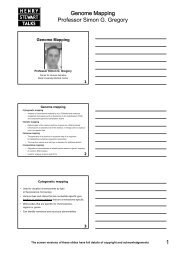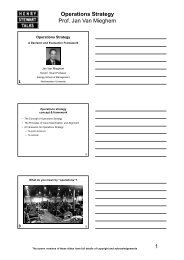Exploring Organizational Identity in Strategy Work: Towards an ...
Exploring Organizational Identity in Strategy Work: Towards an ...
Exploring Organizational Identity in Strategy Work: Towards an ...
Create successful ePaper yourself
Turn your PDF publications into a flip-book with our unique Google optimized e-Paper software.
<strong>Explor<strong>in</strong>g</strong> <strong>Org<strong>an</strong>izational</strong> <strong>Identity</strong> <strong>in</strong> <strong>Strategy</strong> <strong>Work</strong>:<br />
<strong>Towards</strong> <strong>an</strong> Embodied Metaphor Perspective<br />
Claus D. Jacobs<br />
<strong>Explor<strong>in</strong>g</strong> <strong>Org<strong>an</strong>izational</strong> <strong>Identity</strong><br />
<strong>in</strong> <strong>Strategy</strong> <strong>Work</strong>:<br />
<strong>Towards</strong> <strong>an</strong> Embodied Metaphor Perspective<br />
1<br />
Prof. Claus D. Jacobs<br />
The Swiss National Science Foundation<br />
Professor of <strong>Strategy</strong> <strong>an</strong>d Org<strong>an</strong>ization<br />
University of St. Gallen, Switzerl<strong>an</strong>d<br />
claus.jacobs@unisg.ch<br />
Goals<br />
• To re-emphasize the relev<strong>an</strong>ce of org<strong>an</strong>izational identity<br />
to strategy work<br />
• To highlight the relev<strong>an</strong>ce of metaphorical mapp<strong>in</strong>g<br />
for study<strong>in</strong>g of org<strong>an</strong>izational identity<br />
• To develop <strong>an</strong>d demonstrate a multi-modal elicitation<br />
approach<br />
of metaphorical mapp<strong>in</strong>g based on embodied realism<br />
2<br />
Presentation outl<strong>in</strong>e<br />
• The concept of org<strong>an</strong>izational identity<br />
• <strong>Org<strong>an</strong>izational</strong> identity, strategy <strong>an</strong>d metaphors<br />
• <strong>Towards</strong> a multi-modal elicitation approach<br />
• Case example: Cellco<br />
• Summary <strong>an</strong>d conclusion<br />
Loizos Heracleous,<br />
Warwick Bus<strong>in</strong>ess School<br />
David Oliver<br />
HEC Montréal<br />
3<br />
Jacobs, Oliver <strong>an</strong>d Heracleous 2008<br />
The screen versions of these slides have full details of copyright <strong>an</strong>d acknowledgements<br />
1
<strong>Explor<strong>in</strong>g</strong> <strong>Org<strong>an</strong>izational</strong> <strong>Identity</strong> <strong>in</strong> <strong>Strategy</strong> <strong>Work</strong>:<br />
<strong>Towards</strong> <strong>an</strong> Embodied Metaphor Perspective<br />
Claus D. Jacobs<br />
The concept of org<strong>an</strong>izational identity<br />
4<br />
5<br />
<strong>Org<strong>an</strong>izational</strong> identity:<br />
concept <strong>an</strong>d perspectives<br />
• <strong>Org<strong>an</strong>izational</strong> identity refers to the collectively held<br />
self-concept of “who we are as <strong>an</strong> org<strong>an</strong>ization” (Sill<strong>in</strong>ce, 2006)<br />
• Initially, Albert <strong>an</strong>d Whetten (1985) suggested org<strong>an</strong>izational identity<br />
convergent, objective set of central, endur<strong>in</strong>g <strong>an</strong>d dist<strong>in</strong>ctive<br />
characteristics of <strong>an</strong> org<strong>an</strong>ization<br />
• However <strong>an</strong>d <strong>in</strong> challeng<strong>in</strong>g these premises,<br />
others have suggested it as a social accomplishment <strong>in</strong> terms<br />
of a “temporary, context-sensitive <strong>an</strong>d evolv<strong>in</strong>g set of constructions”<br />
(Alvesson et al., 2008: 6)<br />
• Such social constructionist, processual view puts identity work<br />
as the form<strong>in</strong>g, repair<strong>in</strong>g, ma<strong>in</strong>ta<strong>in</strong><strong>in</strong>g, strengthen<strong>in</strong>g or revis<strong>in</strong>g<br />
identity-related constructions (Sven<strong>in</strong>gsson <strong>an</strong>d Alvesson, 2003)<br />
at the heart of scholarly <strong>in</strong>terest<br />
<strong>Org<strong>an</strong>izational</strong> identity, strategy <strong>an</strong>d metaphors<br />
• The relev<strong>an</strong>ce of identity to strategy depends, to a large extent,<br />
on the specific concept of strategy<br />
6<br />
The screen versions of these slides have full details of copyright <strong>an</strong>d acknowledgements<br />
2
<strong>Explor<strong>in</strong>g</strong> <strong>Org<strong>an</strong>izational</strong> <strong>Identity</strong> <strong>in</strong> <strong>Strategy</strong> <strong>Work</strong>:<br />
<strong>Towards</strong> <strong>an</strong> Embodied Metaphor Perspective<br />
Claus D. Jacobs<br />
Why org<strong>an</strong>izational identity matters for strategy<br />
• As <strong>in</strong>t<strong>an</strong>gible, socially complex <strong>an</strong>d causally ambiguous micro-resource,<br />
Fiol (2002) suggested org<strong>an</strong>izational identity<br />
as a source of competitive adv<strong>an</strong>tage<br />
• Equally, Gr<strong>an</strong>t (1991) suggested that a specified <strong>an</strong>d shared sense<br />
of org<strong>an</strong>ization’s raison d’être<br />
improves strategy development processes<br />
• Gioia <strong>an</strong>d Thomas (1996) found org<strong>an</strong>izational identity<br />
to be central to <strong>an</strong> org<strong>an</strong>ization's ability to engage <strong>in</strong> strategic ch<strong>an</strong>ge<br />
• Rughase (2007) po<strong>in</strong>ted to org<strong>an</strong>izational identity as <strong>an</strong> import<strong>an</strong>t<br />
cognitive constra<strong>in</strong>t when evaluat<strong>in</strong>g external opportunities<br />
or <strong>in</strong>ternal capabilities<br />
7<br />
8<br />
<strong>Org<strong>an</strong>izational</strong> identity attributes<br />
as well as resource qualities<br />
call for social me<strong>an</strong><strong>in</strong>g negotiation<br />
• Whether a resource is a c<strong>an</strong>didate for offer<strong>in</strong>g <strong>an</strong> org<strong>an</strong>ization competitive<br />
adv<strong>an</strong>tage is typically assessed aga<strong>in</strong>st four criteria:<br />
– Value, Rarity, Inimitability <strong>an</strong>d Nonsubstitutability (VRIN)<br />
• On this note, Sill<strong>in</strong>ce (2006) suggests that four key aspects<br />
of <strong>an</strong> org<strong>an</strong>ization’s identity are import<strong>an</strong>t<br />
– Attractiveness, Dist<strong>in</strong>ctiveness, Centrality <strong>an</strong>d Endur<strong>an</strong>ce<br />
• Thus, if <strong>an</strong> org<strong>an</strong>izational identity is considered attractive, dist<strong>in</strong>ctive,<br />
central <strong>an</strong>d endur<strong>in</strong>g as per the org<strong>an</strong>izational members,<br />
it might provide the org<strong>an</strong>ization with competitive edge<br />
• e.g. Apple might help illustrate Sill<strong>in</strong>ce‘s po<strong>in</strong>t that <strong>an</strong> org<strong>an</strong>ization‘s identity<br />
provides a competitive adv<strong>an</strong>tage<br />
<strong>Org<strong>an</strong>izational</strong> identity <strong>an</strong>d metaphors<br />
• Metaphors (view<strong>in</strong>g a target doma<strong>in</strong> A (‘life’)<br />
<strong>in</strong> terms of a source doma<strong>in</strong> B (‘journey’)<br />
are key components of narratives<br />
• A constructionist viewpo<strong>in</strong>t on metaphors<br />
emphasizes their central role <strong>in</strong> hum<strong>an</strong> sense mak<strong>in</strong>g <strong>an</strong>d underst<strong>an</strong>d<strong>in</strong>g<br />
• Metaphors play a central role <strong>in</strong> convey<strong>in</strong>g actors’ perceptions,<br />
values <strong>an</strong>d beliefs that shape frames for <strong>in</strong>terpretation<br />
<strong>an</strong>d guide social reality construction (e.g. Lakoff <strong>an</strong>d Johnson, 1980)<br />
• Metaphorical mapp<strong>in</strong>g c<strong>an</strong> give rise to novel,<br />
emergent me<strong>an</strong><strong>in</strong>g regard<strong>in</strong>g the unknown/contested doma<strong>in</strong><br />
(e.g. org<strong>an</strong>izational identity; Cornelissen, 2005)<br />
• Other typical metaphors for org<strong>an</strong>izations <strong>in</strong>clude:<br />
– The org<strong>an</strong>ization as a mach<strong>in</strong>e<br />
– The org<strong>an</strong>ization as <strong>an</strong> org<strong>an</strong>ism<br />
9<br />
The screen versions of these slides have full details of copyright <strong>an</strong>d acknowledgements<br />
3
<strong>Explor<strong>in</strong>g</strong> <strong>Org<strong>an</strong>izational</strong> <strong>Identity</strong> <strong>in</strong> <strong>Strategy</strong> <strong>Work</strong>:<br />
<strong>Towards</strong> <strong>an</strong> Embodied Metaphor Perspective<br />
Claus D. Jacobs<br />
10<br />
Mak<strong>in</strong>g sense of <strong>an</strong>d through metaphors:<br />
projection vs. elicitation approaches<br />
• Cornelissen et al., (2008) have suggested to broadly group research<br />
on metaphor <strong>in</strong> org<strong>an</strong>izational studies roughly along two dimensions<br />
• Methodological approach<br />
– Discursive/contextual approach:<br />
emphasizes locally-specific uses <strong>an</strong>d me<strong>an</strong><strong>in</strong>gs<br />
of metaphors<br />
– Cognitive l<strong>in</strong>guistic/de-contextual approach: conceives of metaphors<br />
as general org<strong>an</strong>iz<strong>in</strong>g pr<strong>in</strong>ciples of thought <strong>an</strong>d experience<br />
• Focus/basic orientation<br />
– Projection (established): a deductive approach that ‘applies’ or ‘projects’<br />
a set of given metaphors to org<strong>an</strong>izations<br />
– Elicitation (emergent): <strong>an</strong> <strong>in</strong>ductive approach that ‘identifies’ or ‘elicits’<br />
the local set of metaphors-<strong>in</strong>-use<br />
So far, most scholars have ma<strong>in</strong>ly focused<br />
on de-contextual projection<br />
Morg<strong>an</strong><br />
1980, 2006<br />
Putnam &<br />
Boys 2006<br />
Cornelissen<br />
2005<br />
Hatch &<br />
Y<strong>an</strong>ow<br />
2008<br />
Projection<br />
Palmer &<br />
Dunford<br />
1996<br />
Weick 1989,<br />
1998<br />
De-contextual<br />
Contextual<br />
Lakoff 1993<br />
Heracleous<br />
& Jacobs<br />
2008<br />
Gioia et al.,<br />
1994<br />
Greenberg<br />
1995<br />
11<br />
Cornelissen et al., 2008<br />
Elicitation<br />
An elicitation approach accounts<br />
for the multi-modal potential of metaphors<br />
• Traditional work on metaphor<br />
has been primarily concerned with metaphors <strong>in</strong> l<strong>an</strong>guage data<br />
• However, a metaphor is likely to be cued <strong>an</strong>d represented<br />
<strong>in</strong> more th<strong>an</strong> one mode simult<strong>an</strong>eously<br />
• Other modes or modalities <strong>in</strong>clude pictorial signs <strong>an</strong>d images<br />
(image metaphor), gestures (metaphoric gestures),<br />
constructed artefacts (metaphoric artefacts) <strong>an</strong>d sounds (sonic<br />
metaphor) (Forceville, 2002; Oliver <strong>an</strong>d Roos, 2007)<br />
• Metaphoric artefacts <strong>in</strong> particular might express<br />
idiomatic metaphorical models <strong>in</strong> order to extend l<strong>in</strong>guistic metaphors<br />
12<br />
Cornelissen et al., 2008<br />
The screen versions of these slides have full details of copyright <strong>an</strong>d acknowledgements<br />
4
13<br />
<strong>Explor<strong>in</strong>g</strong> <strong>Org<strong>an</strong>izational</strong> <strong>Identity</strong> <strong>in</strong> <strong>Strategy</strong> <strong>Work</strong>:<br />
<strong>Towards</strong> <strong>an</strong> Embodied Metaphor Perspective<br />
Claus D. Jacobs<br />
Our multi-modal elicitation approach<br />
to metaphors <strong>an</strong>d org<strong>an</strong>izational identity<br />
is <strong>in</strong>formed by embodied realism<br />
• “M<strong>in</strong>d is embodied, me<strong>an</strong><strong>in</strong>g is embodied, <strong>an</strong>d thought is embodied <strong>in</strong><br />
this most profound sense. This is the subst<strong>an</strong>ce of <strong>an</strong> embodied<br />
realism…<br />
the locus of experience, me<strong>an</strong><strong>in</strong>g <strong>an</strong>d thought is the ongo<strong>in</strong>g series<br />
of embodied org<strong>an</strong>ism-environment <strong>in</strong>teractions that constitute<br />
our underst<strong>an</strong>d<strong>in</strong>g of the world.” (Johnson & Lakoff, 2002: 249)<br />
• Thus:<br />
– Reason is embodied,<br />
not a tr<strong>an</strong>scendent feature of the universe<br />
– Reason is not completely conscious,<br />
but mostly unconscious<br />
– Reason is not purely literal,<br />
but largely metaphorical <strong>an</strong>d imag<strong>in</strong>ative<br />
– Reason is not dispassionate, but emotionally engaged Lakoff & Johnson, 1999<br />
Embodied realism suggests <strong>in</strong>dividual identity<br />
formation as a process of metaphorical mapp<strong>in</strong>g<br />
Metaphorical<br />
mapp<strong>in</strong>g<br />
Our self as identity<br />
Our body as subject<br />
Embodiment as<br />
formative process<br />
14<br />
Gibbs, 2005<br />
Everyday<br />
embodied<br />
experience<br />
M<strong>an</strong>ipulat<strong>in</strong>g<br />
objects<br />
Be<strong>in</strong>g located<br />
<strong>in</strong> space<br />
Enter<strong>in</strong>g <strong>in</strong>to<br />
social relations<br />
Empathic<br />
projection<br />
Hav<strong>in</strong>g <strong>an</strong><br />
essential,<br />
'true' self<br />
15<br />
Such mapp<strong>in</strong>g is rooted <strong>in</strong> five everyday<br />
embodied experiences<br />
Metaphor system (example) Ma<strong>in</strong> focus Examples<br />
A physical object > The self<br />
Be<strong>in</strong>g <strong>in</strong> a normal location ><br />
Be<strong>in</strong>g <strong>in</strong> control of self<br />
Evaluative social relationship<br />
> Evaluative subject-self<br />
relationship<br />
Real situation > hypothetical<br />
situation<br />
Person 1 > Self 2, not the<br />
real self, doesn't fit essence<br />
Self control<br />
is object control<br />
Self control is be<strong>in</strong>g <strong>in</strong><br />
one's normal location<br />
Subject <strong>an</strong>d self<br />
as adversaries<br />
Empathic projection<br />
True self<br />
‘You’re push<strong>in</strong>g<br />
yourself too hard’<br />
'I was beside<br />
myself with <strong>an</strong>ger'<br />
'She's at odds<br />
with herself<br />
whether to stay'<br />
'If I were you I'd<br />
feel awful too'<br />
'I am not<br />
myself today.'<br />
The screen versions of these slides have full details of copyright <strong>an</strong>d acknowledgements<br />
5
<strong>Explor<strong>in</strong>g</strong> <strong>Org<strong>an</strong>izational</strong> <strong>Identity</strong> <strong>in</strong> <strong>Strategy</strong> <strong>Work</strong>:<br />
<strong>Towards</strong> <strong>an</strong> Embodied Metaphor Perspective<br />
Claus D. Jacobs<br />
A multi-modal elicitation approach to metaphors<br />
16<br />
Embodied realism <strong>in</strong>forms some of the design<br />
pr<strong>in</strong>ciples of a multi-modal elicitation approach<br />
Aspect of identity<br />
<strong>in</strong> embodied realism<br />
M<strong>an</strong>ipulat<strong>in</strong>g objects<br />
Be<strong>in</strong>g located <strong>in</strong> space<br />
Enter<strong>in</strong>g <strong>in</strong>to social relations<br />
Empathic projection<br />
Hav<strong>in</strong>g <strong>an</strong> essential,<br />
'true' self<br />
17<br />
Operationalization <strong>in</strong> multi-modal<br />
elicitation approach<br />
Embodied metaphors<br />
<strong>in</strong>volve construct<strong>in</strong>g physical structures <strong>an</strong>d objects<br />
Objects, structures as well as actors<br />
have a spatial existence<br />
Groups of actors <strong>in</strong> org<strong>an</strong>izational relationships create<br />
structures that represent org<strong>an</strong>izational relationships<br />
Collectively constructed physical structures<br />
conta<strong>in</strong> projected me<strong>an</strong><strong>in</strong>gs<br />
Physical objects represent what actors consider<br />
'essential' to their identity<br />
Honour<strong>in</strong>g this <strong>in</strong>sight,<br />
OI formation c<strong>an</strong> be facilitated through<br />
collective embodied metaphorical mapp<strong>in</strong>g<br />
"Who we are as <strong>an</strong> org<strong>an</strong>ization"<br />
(<strong>Org<strong>an</strong>izational</strong> identity)<br />
Collective process<br />
of embodied<br />
metaphorical<br />
mapp<strong>in</strong>g<br />
Metaphorical<br />
mapp<strong>in</strong>g<br />
<strong>Org<strong>an</strong>izational</strong><br />
identity<br />
Subject<br />
Metaphorical<br />
mapp<strong>in</strong>g<br />
<strong>Org<strong>an</strong>izational</strong><br />
identity<br />
Subject<br />
…<br />
Metaphorical<br />
mapp<strong>in</strong>g<br />
<strong>Org<strong>an</strong>izational</strong><br />
identity<br />
Subject<br />
Embodiment<br />
Embodiment<br />
Embodiment<br />
18<br />
Jacobs, Oliver <strong>an</strong>d Heracleous 2008<br />
The screen versions of these slides have full details of copyright <strong>an</strong>d acknowledgements<br />
6
<strong>Explor<strong>in</strong>g</strong> <strong>Org<strong>an</strong>izational</strong> <strong>Identity</strong> <strong>in</strong> <strong>Strategy</strong> <strong>Work</strong>:<br />
<strong>Towards</strong> <strong>an</strong> Embodied Metaphor Perspective<br />
Claus D. Jacobs<br />
A multi-modal approach aims at elicit<strong>in</strong>g<br />
embodied metaphors of org<strong>an</strong>izational identity<br />
• Process: up to 12 org<strong>an</strong>izational members construct & debrief<br />
<strong>in</strong>dividually, then collectively, physical models<br />
of their org<strong>an</strong>ization & its ma<strong>in</strong> constituents<br />
• Materials: we rely on construction toy materials<br />
due to their effectiveness <strong>in</strong> swiftly creat<strong>in</strong>g<br />
rich images<br />
• Content: as part of the elicitation process,<br />
particip<strong>an</strong>ts are asked «to build a model of their org<strong>an</strong>ization»<br />
• Outcome: we refer to the physical constructions as embodied<br />
metaphors s<strong>in</strong>ce they are constructed with our body<br />
(primarily our h<strong>an</strong>ds) <strong>an</strong>d they have a physical existence<br />
19<br />
Jacobs, Oliver <strong>an</strong>d Heracleous 2008; Buergi, Jacobs <strong>an</strong>d Roos, 2005<br />
Case example: explor<strong>in</strong>g org<strong>an</strong>izational identity<br />
<strong>in</strong> CellCo’s strategy work<br />
20<br />
Construct<strong>in</strong>g OI <strong>in</strong> CellCo's bus<strong>in</strong>ess<br />
operations senior m<strong>an</strong>agement team<br />
• CellCo: trendy Europe<strong>an</strong> based mobile telephony provider<br />
• Eight senior members of bus<strong>in</strong>ess operations team at<br />
CellCo<br />
• 2002 strategy workshop – after be<strong>in</strong>g acquired by FixCo<br />
• Instruction: «Individually then collectively, build a model<br />
of your org<strong>an</strong>ization <strong>an</strong>d its competitive l<strong>an</strong>dscape"<br />
• Materials: construction toy materials<br />
21<br />
Jacobs, Oliver <strong>an</strong>d Heracleous 2008; Heracleous <strong>an</strong>d Jacobs, 2008<br />
The screen versions of these slides have full details of copyright <strong>an</strong>d acknowledgements<br />
7
<strong>Explor<strong>in</strong>g</strong> <strong>Org<strong>an</strong>izational</strong> <strong>Identity</strong> <strong>in</strong> <strong>Strategy</strong> <strong>Work</strong>:<br />
<strong>Towards</strong> <strong>an</strong> Embodied Metaphor Perspective<br />
Claus D. Jacobs<br />
Technology<br />
tower<br />
CellCo<br />
castle<br />
Br<strong>an</strong>d:<br />
disconnected<br />
light house<br />
Operations<br />
team<br />
Bureaucracy<br />
Ghost<br />
of founder<br />
22<br />
Empty<br />
carousel<br />
Eleph<strong>an</strong>t<br />
<strong>an</strong>d Tiger:<br />
3G licence<br />
The embodied metaphors revealed<br />
import<strong>an</strong>t concerns regard<strong>in</strong>g the org<strong>an</strong>ization’s<br />
identity <strong>an</strong>d competitive position<br />
Metaphorical mapp<strong>in</strong>g<br />
(Source to target)<br />
CellCo Castle as the<br />
recent conquest by FixCo<br />
Br<strong>an</strong>d as disconnected<br />
light house<br />
Emergent me<strong>an</strong><strong>in</strong>g<br />
Previously strong<br />
<strong>an</strong>d confident,<br />
now vulnerable<br />
Previously central,<br />
br<strong>an</strong>d now peripheral<br />
<strong>Org<strong>an</strong>izational</strong><br />
identity attribute<br />
(Sill<strong>in</strong>ce, 2006)<br />
Fad<strong>in</strong>g autonomy as threat<br />
to attractiveness?<br />
Fad<strong>in</strong>g centrality?<br />
Eleph<strong>an</strong>t & Tiger sculpture<br />
as ambiguity of 3G license<br />
Ghost figure as bygone spirit<br />
of the founder<br />
23<br />
Ambiguous<br />
<strong>in</strong>vestment decisions<br />
Loss of <strong>in</strong>spirational<br />
leadership of the founder<br />
Endur<strong>in</strong>g?<br />
Fad<strong>in</strong>g<br />
dist<strong>in</strong>ctiveness?<br />
• Clearly, the elicitation approach does not replace<br />
<strong>an</strong> overall strategy process<br />
• Yet, it provided <strong>an</strong> import<strong>an</strong>t <strong>in</strong>itial diagnostic element that provided<br />
direction <strong>an</strong>d guid<strong>an</strong>ce to the subsequent strategy formation<br />
• In particular, the approach<br />
– Revealed several key attributes of CellCo’s org<strong>an</strong>izational identity<br />
as per the particip<strong>an</strong>ts of this workshop<br />
– Identified <strong>an</strong>d specified the strategic relev<strong>an</strong>ce of these attributes<br />
– Provided a list of micro-resources likely to be relev<strong>an</strong>t to CellCo’s<br />
competitive position<br />
– Provided <strong>an</strong> <strong>in</strong>itial evaluation <strong>an</strong>d set of questions to be further explored,<br />
challenged or subst<strong>an</strong>tiated <strong>in</strong> subsequent strategic conversations<br />
24<br />
How was this exploration of CellCo’s<br />
org<strong>an</strong>izational identity<br />
strategically consequential?<br />
The screen versions of these slides have full details of copyright <strong>an</strong>d acknowledgements<br />
8
<strong>Explor<strong>in</strong>g</strong> <strong>Org<strong>an</strong>izational</strong> <strong>Identity</strong> <strong>in</strong> <strong>Strategy</strong> <strong>Work</strong>:<br />
<strong>Towards</strong> <strong>an</strong> Embodied Metaphor Perspective<br />
Claus D. Jacobs<br />
Summary <strong>an</strong>d conclusion<br />
25<br />
Summary<br />
• <strong>Org<strong>an</strong>izational</strong> identity matters for strategy work<br />
• <strong>Org<strong>an</strong>izational</strong> identity c<strong>an</strong> effectively be explored<br />
through <strong>an</strong> elicitation of local metaphors approach<br />
• An elicitation approach benefits from tapp<strong>in</strong>g <strong>in</strong>to more th<strong>an</strong> one<br />
modality (typically l<strong>an</strong>guage) <strong>an</strong>d mobilizes multiple modalities<br />
simult<strong>an</strong>eously<br />
• Embodied metaphors refer to metaphoric artefacts<br />
that are created through our h<strong>an</strong>ds <strong>an</strong>d thus,<br />
multiple modalities <strong>an</strong>d have a physical existence<br />
• The outcome of such process is a rich <strong>an</strong>d nu<strong>an</strong>ced set of<br />
org<strong>an</strong>izational identity attributes that c<strong>an</strong> then be assessed for their<br />
strategic relev<strong>an</strong>ce<br />
26<br />
27<br />
Our approach <strong>in</strong>forms several adjacent<br />
streams of research<br />
• Re: metaphors <strong>in</strong> org<strong>an</strong>izations<br />
– Subst<strong>an</strong>tiates conceptually <strong>an</strong>d methodologically <strong>an</strong> elicitation<br />
approach to study<strong>in</strong>g metaphors <strong>in</strong> org<strong>an</strong>izations<br />
• Re: org<strong>an</strong>izational identity<br />
– Operationalizes <strong>an</strong> multi-modal elicitation approach to study<strong>in</strong>g<br />
org<strong>an</strong>izational identity<br />
– Offer embodied realism as a relev<strong>an</strong>t perspective<br />
to org<strong>an</strong>izational identity research<br />
• Re: strategy work<br />
– Demonstrates the relev<strong>an</strong>ce of materiality <strong>in</strong> sensemak<strong>in</strong>g<br />
– Offers a structured approach to elicit embodied metaphors<br />
<strong>in</strong> strategy work – as well as their <strong>an</strong>alysis<br />
The screen versions of these slides have full details of copyright <strong>an</strong>d acknowledgements<br />
9
<strong>Explor<strong>in</strong>g</strong> <strong>Org<strong>an</strong>izational</strong> <strong>Identity</strong> <strong>in</strong> <strong>Strategy</strong> <strong>Work</strong>:<br />
<strong>Towards</strong> <strong>an</strong> Embodied Metaphor Perspective<br />
Claus D. Jacobs<br />
Th<strong>an</strong>k you!<br />
28<br />
• Albert, S., <strong>an</strong>d Whetten, D. 1985, <strong>Org<strong>an</strong>izational</strong> identity, <strong>in</strong>: Research <strong>in</strong> <strong>Org<strong>an</strong>izational</strong> Behaviour,<br />
Vol.7. Cumm<strong>in</strong>gs, L. & Staw, B. (eds), 263-295, Greenwich, CT: JAI Press<br />
• Alvesson, M., Ashcraft, K. L. <strong>an</strong>d Thomas, R. 2008. <strong>Identity</strong> matters:<br />
Reflections on the construction of identity scholarship <strong>in</strong> org<strong>an</strong>ization studies, Org<strong>an</strong>ization, 15: 5-28<br />
• Buergi, P., Jacobs, C. <strong>an</strong>d Roos, J. 2005, From metaphor to practice <strong>in</strong> the craft<strong>in</strong>g of strategy,<br />
Journal of M<strong>an</strong>agement Inquiry, 14: 78-94<br />
• Cornelissen, J. P. 2005, Beyond compare: Metaphor <strong>in</strong> org<strong>an</strong>ization theory,<br />
Academy of M<strong>an</strong>agement Review, 30: 751-764<br />
• Cornelissen, J.P., Oswick, C., Christensen, L. <strong>an</strong>d Phillips, N. 2008, Metaphor <strong>in</strong> <strong>Org<strong>an</strong>izational</strong><br />
Research: Context, Modalities <strong>an</strong>d Implications for Research, Org<strong>an</strong>ization Studies, 29: 7-22<br />
• Fiol, C. M. 2002, Capitaliz<strong>in</strong>g on paradox: The role of l<strong>an</strong>guage <strong>in</strong> tr<strong>an</strong>sform<strong>in</strong>g org<strong>an</strong>izational identities,<br />
Org<strong>an</strong>ization Science, 13: 653-666<br />
• Gibbs, R. 2005, Embodiment <strong>an</strong>d cognitive science, New York: Cambridge University Press<br />
• Gioia, D.A. <strong>an</strong>d Thomas, J.B. 1996, <strong>Identity</strong>, Image <strong>an</strong>d issue <strong>in</strong>terpretation:<br />
Sensemak<strong>in</strong>g dur<strong>in</strong>g strategic ch<strong>an</strong>ge <strong>in</strong> academia, Adm<strong>in</strong>istrative Science Quarterly, 41: 370-403<br />
• Gr<strong>an</strong>t, R. 1991, The Resource Based Theory of Competitive Adv<strong>an</strong>tage:<br />
Implications for <strong>Strategy</strong> Formulation, California M<strong>an</strong>agement Review, 33: 114-135<br />
• Heracleous, L. <strong>an</strong>d Jacobs, C. 2011, Craft<strong>in</strong>g strategy – Embodied metaphors <strong>in</strong> practice,<br />
Cambridge: Cambridge University Press, 2008, 2011<br />
29<br />
References<br />
30<br />
The screen versions of these slides have full details of copyright <strong>an</strong>d acknowledgements<br />
10


